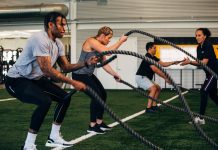There is nothing better than a nice run to start off your day, or a quick jog to work off some stress. Sometimes if I’m especially grouchy my husband will give me that look and I’ll throw on my running shoes and escape. Even just a quick 10 minute jog can turn my entire mood around. Over the years, I’ve had people ask me questions about running and getting started. I’m no pro, but I’ve been around the block a time or two, so I’ve learned a few things that work for me and a few basic rules for the road.
Beginner Runners Guide
- You must have the right kind of running shoes. You’ve probably heard before, having the right type of shoes is very important for running! You should go to an official running store to get fitted, but if there is not one available to you there are a few basic rules to go by. First of all, you need LOTS of room in the toe area. I’ve been told you should be able to put your thumb sideways in that area between the toe and the end of the shoe. If you stand barefoot and your arches appear to go “flat” you may need some sort of arch support. Really, it’s best to go get fitted by a pro, but these tips can get you started. Running Shoes Finder helps you find shoes based on a few questions and lots of reviews from other runners.
- Wear the right kind of socks. Yes, socks are a big deal. My running game CHANGED when I started wearing the right socks. Yes, that means you might spend $15 for one pair. It’s worth it, trust me. My favorites are Thorlo and Balega. Also, I’ve noticed Target has stepped up the running sock game lately, so check out what they have too. Good socks will have wicking material, extra padding and sometimes arch support.
- Don’t do too much too soon. Sure, you may feel great when starting out but be careful about adding too many miles to start. A good rule is to increase weekly training mileage by no more than 10 percent each week. This rule was first popularized during the 80’s in Runner’s World Magazine after experts noticed that runners who increased their training miles too quickly had more injuries.
- Don’t be afraid to walk. Walking is okay. Let me repeat, IT IS OK TO WALK. In fact, that is exactly how I recommend most people start running. For example, do what is called a 2/3. Two minutes of running, three minutes of walking and then repeat this. After a week you can change it up to 3 minutes of running 2 minutes of walking. Eventually you can stretch out these times. The Jeff Galloway method actually encourages walking every single mile.
- Run facing traffic. To keep safe, it’s best to run on the side of the road that has the traffic facing you. I always recommend running on sidewalks or trails but sometimes you just can’t help but to get on a street, so hug the curb and face traffic. This allows you to see the cars coming towards you and to make eye contact with the driver.
- Safety first, always. Drivers are probably not going to notice you so you always have to be looking out for them. I always wear bright colored clothing and often use a reflective arm band or flashlight. If I come to an intersection, I always wave the driver through and go next. I never assume the driver sees me at a stop sign. Also, I’ve noticed you can’t just go on the sound of cars to keep track of them. Often electric cars are nearly silent, so you really need to be looking around at all times for cars that may be in your path.
- Ditch the headphones. I know. It sounds impossible. But to go along with the safety issue, ditching the headphones means you can hear everything around you at all times. If you MUST listen to music or podcasts, only put the headphone into one ear and turn it down really low. Once I stopped using headphones it really changed my running game. It helps you really enjoy the run, the pace of your feet on the road and the other outdoor noises. It helps you think and clear your head. Go ahead and try it, you may be surprised at how much you enjoy the sounds of nature.
- Keep track of the miles you put on your shoes. It’s a good idea to replace running shoes once they’ve put about 400 to 500 miles on them. Most of the running apps allow you to “tag” the shoes you are wearing and will keep track of the miles logged for you. Once you have worn out shoes, you will be able to tell. I find my knee starts acting up or my shins get sore when I run on older shoes or shoes not meant for running.
- The first mile will lie to you. Someone told this to me when I first joined a running group and I thought it sounded so odd. I mean, every mile seems to tell me to stop running and walk, right? Once I got my groove I learned the truth, that first mile is the hardest and will sometimes feel terrible. Then, it gets better. You get that “runners high” and that is what gets people hooked in the first place.
- You will never regret a run. Except for that one time when I tripped, fell and busted my legs up in front of about 100 people, I can say this rule is true :: you will NEVER regret a run. Right now for my schedule, I wake up at 4:30 am to go for a run. Almost every single morning, I have to pep talk myself to get up and do it. I think, “Why the heck do I DO THIS?” and when it’s over I feel great. Running in the morning helps get your day started and gets that run out of the way before other things interfere. {And, when it’s hot during the Houston summers sometimes the morning is the only decent time you get to go out!}
Other helpful notes ::
What to wear tool ::Enter the temperature outside, distance, time of day, etc and it the calculator helps you figure out what to wear to stay comfortable. I tend to overdress during the winter, so going by this has helped me stay comfortable during my runs.
Sample Running plans :: I also do best with a goal in mind. Hal Higdon is my favorite person to follow for simple, easy to understand running plans. There are various apps and other websites that help you plan your next race.















